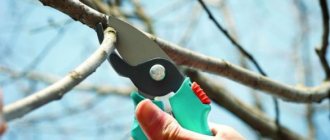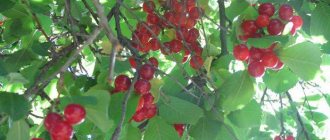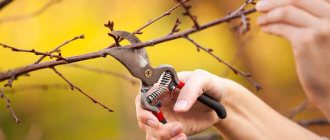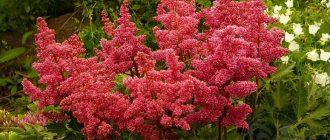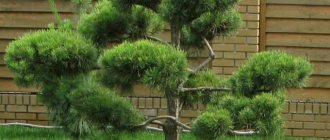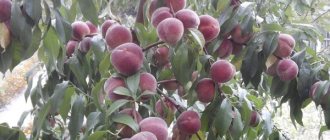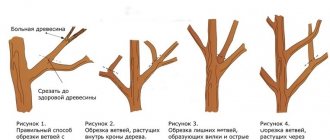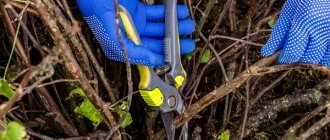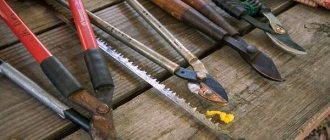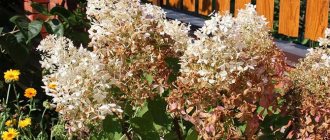Category: Growing and care Reading time: 9 min · Views: 944
Felt cherry, originally from China, is loved by Russian gardeners because of its ease of care and delicious berries. A special feature of this type of cherry is the small, almost dwarf size of the tree. It looks more like a shrub than a tree, and its yield is several times higher than that of an ordinary cherry. Pruning felt cherries in autumn and spring directly affects the size of the harvest. Care tips, recommendations from experienced gardeners.
Varietal characteristics
Garden felt cherry is a dwarf tree native to China. It reaches a height of up to 2 m, and the branches spread out to 1.5 m. The crop is grown for many reasons:
- rapid growth and fruiting in all climatic zones with the exception of the Arctic;
- abundant and colorful flowering, reminiscent of sakura;
- compactness of the trunk and crown;
- high yield - about 20 kg of berries are harvested from one plant;
- early fruiting - berries ripen 2 years after planting;
- early fruit formation - cherries appear in mid-summer and are easily picked from the bush;
- resistance to diseases (coccomycosis, fungi), pests and frosts down to -30 degrees;
- drought resistance, while practically no shoots are formed.
The disadvantages of the variety include a tendency to be affected by moniliosis and root rot during warming. However, the usefulness of fruits with a high content of vitamin C, PP, and carbohydrates makes the felt cherry a favorite of gardeners. The plant does not live long - about 10-15 years. But timely pruning of branches in the fall prolongs the activity of fruit formation to 20-25 years.
Why does the felt cherry tree not bear fruit? Felt cherry blossoms, but does not bear fruit
Felt cherry is popular for its compact size, decorativeness during flowering and abundant fruiting. But its cultivation does not always go without problems. Gardeners often face the problem that the felt cherry blossoms profusely, but does not bear fruit, and here you should know why this happens and what needs to be done.
The main reasons for poor fruiting of felt cherries
Reasons for poor fruiting include:
- Single landing. This is due to the fact that this plant is self-fertile, that is, it requires cross-pollination to produce berries.
- Incorrect landing site.
- Early age. A cherry planted as a seedling begins to bear fruit well only 2-3 years after planting, and as a seed - in 4-5 years. Before this, the tree only blooms profusely and can produce several single berries.
- Excessive pruning. Since not all branches on a tree bear fruit, you should know which ones can be cut and which ones cannot.
What to do if the felt cherry tree does not bear fruit?
Be sure to plant several (at least 3) cherries within one garden. These can be seedlings of one variety or several.
Felt cherry bears fruit poorly in insufficient light and when water stagnates in the soil around it. It is not recommended to replant an already established plant, so these problems should be solved by other methods: pruning neighboring plants or arranging water outflow.
Felt cherry trees should be pruned annually. In this case, it is necessary to cut only branches that have already bear fruit for 5 years. Do not touch young shoots and bouquet branches, on which berries will grow in 2 years.
If you follow the recommendations given in the article, you can annually collect delicious sweet and sour berries in large quantities for 15 years.
Need for pruning
Early fruiting, short growth and spreading crown lead to rapid drying of the trunk. Proper pruning of dwarf felt cherry, done in the fall, will increase the quality of the harvest and life expectancy. Molding and sanitary renewal of the crown are necessary to obtain large berries and remove diseased and insect-infested branches. The purpose of the measures is complete pruning:
- branches from the side parts, deepened into the crown;
- shoots that have weakened or dried out after fruiting;
- old branches that do not produce branches and do not bear fruit;
- an excess of branches to maintain the quality and quantity of berries.
The crop is not only pruned in the fall. Spring and summer removal of shoots is allowed.
Basic types of branch deletion
Cherry pruning should be carried out taking into account the biological characteristics of its growth, crown shape, fruiting dynamics and branching. Depending on the direction, there are several types of pruning.
Thinning branches
The shoots are completely removed, due to which the crown becomes compact and the “tops” practically do not grow. It is used only on thickened fruit crops.
Non-selective removal
The branch is cut off above the bud in order to obtain young shoots. The material grows from buds located above the cut area. With this procedure, the volume of the crown is preserved, but the tree looks fluffy.
Selective circumcision
If you prune limbs this way, remove them selectively. Make a cut line above the side shoot for wide branches, and remove thin ones to the bud. This preserves the height and density of the crop.
Plant molding
Spring is a good time for crown formation. The work is carried out before the start of bud formation, in the second half of March. Skeletal and lateral shoots are cut from the tree. You can leave about 10 skeletal outgrowths, but every year they need to be shortened by a third. Try to keep the distance between the shoots 10-15 cm. When forming the crown, you can shorten the remaining branches a little - they will grow back quickly.
Sanitation procedures
During the spring, summer or autumn procedure, unhealthy, shrunken, broken and weakened elements are removed. Branches with growth defects must be cut out. If a cherry or sweet cherry is affected by a fungus, the shoots are immediately removed.
Anti-aging activities
Cherry pruning is carried out in the autumn after leaf fall, in September or early October. Since the plant bushes quickly, the procedure is carried out 7-8 years after planting. On annual shoots, fruits form faster, so sections of the crown older than 3 years are removed to the outer bud. Rejuvenating procedures are divided into weak - they get rid of growth in 2 years, medium - they remove branches formed over 4 years, strong - they cut out branches that have grown over 6 years. Depending on the type of work with cherry plantations, their age and variety, the sequence of cutting the material is selected.
Cherry orchard age and pruning
Felt cherry is a bush crop whose branches are shortened by ½ or 1/3 the size. Stone fruit fruiting occurs only on last year's branches. Therefore, semi-skeletal and skeletal shoots are cut to the level of lateral branches in order to accelerate their growth and upward direction. During spring work, it is permissible to shorten the elements at the level of the dormant bud. To better tolerate the cherry procedure, sections of skeletal and semi-skeletal material are alternated every other year. Annual branches are not touched; only long ones (about 50 cm) are removed.
How to work with young cultures?
Stone fruit varieties differ in the speed of crown development, so there is no need to delay pruning. Every year, before budding begins or in the fall, branches are removed. When performing gardening activities, you need to consider the following nuances:
- annual plants will freeze if shoots are removed before wintering;
- young plantings are pruned later than others;
- work only with a saw or a sharp knife, removing loose elements under the ring;
- damaged areas are coated with garden varnish;
- knots should be located at a distance of 10-13 cm from each other.
Crown formation is possible only for seedlings over 2 years old. Forming is combined with thinning, removing branches more than 50 cm in length. The work follows the following scheme:
- Select 6 main shoots, 8-15 cm apart from each other.
- Cut out the rest of the vegetation, giving the crown a ring shape.
- Branches facing the trunk are removed.
- Leave one parallel element at an acute angle.
This gives a mature cherry tree approximately 15 main branches. They expand without limitation, but for convenient collection of fruits they are periodically thinned out.
Rules for pruning fruiting crops
Felt cherry loses crown volume with age. At the bases of large knots, shoots called “tops” appear. In order to improve the quality of the harvest, the cherry orchard is rejuvenated by removing no more than 1-2 meters of the crown. Exceeding the norm will lead to death or disease of the tree. The cut is made above the branches with fruits, in several stages, if the work has not been carried out for several years.
Features of rejuvenation of old plants
On old trees, dried, non-fruitful and diseased twigs are removed. Sections are made to the level of healthy material. The inclined crown is also removed.
Nuances of the procedure: time, tools
The season for agricultural work depends on the varietal variety of the tree. Shaping pruning of cherries is relevant in the spring before the start of sap flow and bud formation. It is important to remove only the skeletal and side branches. Sanitary and rejuvenating measures are carried out in the fall, after harvesting the fruits and falling leaves. During a sanitary cut, it is necessary to completely remove the diseased, damaged material directed towards the trunk. During the summer growing season, they work with cherries affected by diseases. It is recommended to rejuvenate stone fruits after 8 years in early spring or mid-autumn.
What tool can you use?
The quality of agricultural procedures depends on the use of tools. You will need:
- pruner;
- sharp saw;
- knife;
- hacksaw;
- scissors.
Tools must be treated with antiseptics to prevent plants from being affected by fungal or infectious diseases. The cut areas should be coated with garden varnish.
How to make a garden varnish?
A special plant putty is needed to treat open cuts, damaged wood or burns. Beginning gardeners can purchase Petrolatum, but experienced agronomists recommend making the following compositions for healing tissue yourself:
- nigrolovy. You will need 1 kg of paraffin, nigrol and rosin, which are heated separately. Carefully pour rosin and paraffin into the hot nigrol and mix thoroughly. Before use, you can fill in the ash of tree bark and be sure to improve the putty;
- on wood alcohol. They work with garden varnish in the cold season. To prepare, mix melted lard and fine rosin in proportions of 1:16. The liquid is heated, brought to a homogeneous state and combined with 8 parts of alcohol;
- on beeswax. To make the solution, prepare beeswax, rosin or resin, and linseed oil in a ratio of 4:20:1. First, beeswax is melted, and then rosin is added to it. After mixing, add flax oil. After boiling, you need to add 2 parts of charcoal to the mixture;
- in lard. You need to melt 1 part of lard, add 2 parts of wax to it and bring to a homogeneous state. Then 4 parts of fine rosin are added to the mixture and boiled for 30 minutes. The mass should be poured into cold water and kneaded.
For high-quality healing of cuts, you can add heteroauxin to the garden varnish at the rate of 1 tablet per 1 liter. The solution can be used at any time of the year.
How and with what pruning is done
Formative pruning is carried out already in the second year of the seedling’s life. In early spring, it is necessary to cut off all shoots at a height of 40 cm for tillering of the bush.
- In the third year, again in the spring, all branches are cut to 1/3 of their length.
- After waiting for fruiting, 8–10 strong skeletal shoots are left in the bush. The rest are cut at ground level.
- The pruning pattern is much simpler than that of other shrubs. Cherry bushes are not treated on ceremony because of their enormous growth energy. Even improperly pruned bushes recover quickly.
Over the course of a year, a cherry branch should grow by 30–50 cm. On annual shoots longer than 50 cm, only vegetative buds are formed. To stimulate the formation of fruit buds, they are pruned to 30–40 cm. This procedure is performed not only during spring, but also during summer pruning.
All branches in the crown should be directed outward. By pinching and pruning, incorrectly growing branches can be redirected in the desired direction. In addition, shortening summer annual shoots by pinching allows them to form a larger number of flower buds.
Pinching is easier for the plant to tolerate than pruning. Therefore, in the summer it is worth using this particular regulation technique.
Old and neglected bushes have a large volume of green mass and single fruits on the tops of the shoots. If the new growth of branches is less than 20 cm, the bush must be renewed. In this case, the cherry tree is radically pruned in the spring. 5–6 two-year-old shoots are left, the rest is removed at the root.
Branches are pruned using pruning shears; felt cherry branches are thin. The stems are cut out with a saw or hacksaw. Cuts with a diameter greater than 1 cm are covered with garden pitch.
Before using instruments, they are disinfected in a dark solution of potassium permanganate to prevent the transfer of fungal infection. Pruning bush felt cherries in the spring is the most necessary operation in caring for this crop.
Gardeners in the middle zone are persistently trying to grow peaches and grapes on their plots. The queues for seedlings of pawpaw plants are scheduled for a year in advance. But the completely unpretentious and very productive felt cherry, as well as large-fruited blackthorn and bird cherry, is not particularly popular.
Perhaps these crops need more advertising to increase their spread. Or for novice gardeners there is simply not enough knowledge on the proper care of this excellent and fruitful plant.
Felt cherry is one of the few stone fruit crops that literally grows on its own. There are no industrial plantations, it does not pamper with a huge harvest, and it was named so because the leaves of the felt cherry are not as rough as those of the ordinary one, but soft, like felt. Felt cherry often freezes and remains without a harvest; mainly its flowers die due to returning spring frosts, during which the felt cherry blooms. But if there are no such frosts, then the cherries will please you with a harvest, and, although the fruits will be small and the stone in them will be noticeable, it is still pleasant and healthy to eat them.
Rules for pruning felt cherry. © Linnea Hendrickson
Today, let's talk about pruning felt cherries, because either no one, or very few people, do this, which is why the cherry crown turns into some kind of ball - the center is exposed, the harvest is concentrated on the periphery of the crown, and naturally, it is seriously reduced. To prevent this from happening, we will give a series of useful tips.
Rules and technology for autumn pruning
Dwarf felt cherry tolerates autumn pruning best. This is how its branches remain viable after a long winter. The period of work completion depends on the gardener’s region of residence and the period when sap flow stops. In the southern regions, the procedure can be carried out at the end of September or October, and in the north - at the beginning of September. It is important to control the timing of the event so that the wounds heal quickly and the shoots do not dry out.
Features of the procedure
Gardeners advise how to prune a plant so that it retains its vitality and fruiting quality. So, you need:
- remove large non-skeletal knots that make the crown excessively thick;
- cut off elements located at right angles;
- leave only skeletal crown-forming branches;
- small shoots need to be cut off in the spring;
- do not leave branches growing from the trunk at an acute angle.
Check the location of the branches. In order for stone fruit varieties to rejuvenate, you need to know which shoot will bear fruit. Be sure to treat the cutting areas.
Choosing a Trimming Pattern
The correct pattern of cutting branches guarantees abundant fruiting of cherry trees. Gardeners recommend following the standard procedure when thickening and shaping the crown:
- When decorating, you need to leave 10 skeletal branches. The rest of the material should be removed or trimmed by 1/3. This increases the crop yield and prevents overgrowth of the bush.
- Thickened varieties are cut out almost completely. You need to leave no more than 5-6 shoots 2 years old, and remove the rest at the root. The technique is used to restore the quality of fruiting of an old orchard and rejuvenate it.
The cut areas are treated with varnish and special frost protection agents.
How to prune felted cherries correctly
When going out into the garden with pruning shears in the spring, the summer resident for some reason forgets about the felt cherry. Well, there’s a bush or two growing somewhere and it doesn’t require much attention. Let's figure out whether it is necessary to trim the felt cherry tree and, if necessary, how to do it correctly? And at the same time, in our article we will tell you about the tips and tricks of experienced gardeners for caring for this crop.
articles:
Do Felt Cherry Trees Need to be Trimmed?
Despite the fact that felt cherry grows as a bush, the plant can reach 2-2.5 meters in height and 4.5 m in width. With the help of pruning, you can grow a standard or semi-standard tree.
If the cherry tree grows without shaping and pruning, then the bush quickly thickens due to the large number of branches. And excessive thickening leads to disease damage to the crop and a shift of fruiting to the edges of the crown.
Based on the above, it is necessary to shape and trim felt cherries. The main thing is to do it correctly.
When is the best time to prune cherries?
Beginners in gardening are interested in: when is it better to prune the felt cherry tree, in what time frame?
The optimal time for pruning felt cherries is considered to be the end of March–beginning of April, when the buds begin to swell. The main thing is that pruning the felt cherry must be completed before flowering begins.
Many gardeners argue about the need for summer pruning of felt cherries. You can trim or pinch cherry shoots in July (when new shoots are growing rapidly) if absolutely necessary.
Shoots affected by the fungal disease moniliosis are also cut out. It is better to burn these shoots.
Features of pruning felt cherry
The main thing in felt trimming is to normalize the number of main branches and rejuvenate the crown for optimal lighting.
The old skeletal branches of the cherry tree are cut out to the point where young strong shoots begin to grow.
In any mature felt cherry bush, you can see how a strong shoot begins to grow from the lower part of the skeletal branch - replacing an outdated branch.
Choosing from several such shoots, they leave the one that is more successfully directed.
IMPORTANT! A common cause of death of the felt cherry is the warming of the bark during thawed winters.
Sometimes in an old cherry bush, one large central branch needs to be removed to rejuvenate the entire plant.
Experienced gardeners do not advise cutting out many branches at once in a bush if it is very neglected. The rule here is that less is better, but longer. Pruning can be spread over a couple of seasons. This is not only gradual rejuvenation, but also less stress for the plant.
For better branching, too long shoots of felt cherry can be slightly shortened in the spring.
IMPORTANT! All cuts and saw cuts on felt cherry bushes should be immediately covered with garden paint or varnish.
If any branch in a felt cherry bush grows incorrectly (inside the crown or at an inappropriate angle), it can be bent back. For this purpose, spacers and stretchers are used. But you should not bend old large branches, they are too fragile.
Pruning old felt cherry bushes
Even a very old and neglected felt cherry tree can be rejuvenated by pruning.
Sometimes, when buying a summer cottage, the owner inherits bushes and trees. If you get an old felt cherry bush, don’t rush to uproot it. Felt can and should be rejuvenated! Pruning should begin at the moment the buds on the plant swell, when shrunken, unproductive branches are clearly visible.
Proceed step by step:
- First, inspect the bush for dry, broken or weathered branches. All such branches should be cut either into a ring or into a young side shoot.
- If the bush has very old thick branches, it is worth cutting a couple from the center of the bush to lighten the crown. You can cut it as described above.
- Then, if necessary, you can normalize other branches so that there are no twisted or chafing shoots.
- If it seems that the felt cherry bush is completely dry, do not rush to uproot it. Sometimes cutting down old branches at the base causes strong growth of dormant buds and new young shoots are formed. From these you can form a young cherry bush.
Tips for those who want to plant felt cherries in their garden
And some tips for those who want to grow felt cherries in their garden:
- Choose a sunny and dry place for the bush;
- When planting, do not bury the seedling, do not plant bushes in lowlands where water stands for a long time or snow melts for a long time;
- Treat felt cherry bushes annually against fungal diseases;
- Plant different varieties to ensure better flower pollination and get a good harvest of berries.
With good care and proper pruning, you will get an excellent harvest of delicious berries on your felt cherry.
Source: https://smoldacha.ru/kak_pravilno_obrezat_vishnyu_vojlochnuyu.html
Benefits of Cherry Pruning
The felt variety of the crop must be pruned regularly. Thanks to agricultural manipulations, the plant is formed correctly and looks proportional. Due to the normal density of the branches, the number of fruits increases and their quality increases - the cherries become large and tasty. By removing old branches, you will eliminate the appearance of pests and diseases of the tree, which will be pruned in the fall, will maintain the level of fruiting, and eliminate thickening of the bushes. At the same time, a beautiful, neat crown is formed, which eliminates the complexity of caring for and picking berries. Removing branches will not be difficult if you know the technology of the work.
Cherry is a cold-resistant crop that can easily tolerate low temperatures. But, in order to obtain a full harvest, the tree should be provided with appropriate care in the autumn. Proper preparation for winter is the key to high cherry yields.
Below you will find useful information about preparing a tree for winter, features of care, pruning and covering cherries in the fall. This information will be especially useful for beginning gardeners.
Pruning old cherry trees. Need for pruning
Disputes surrounding such an event as cherry pruning occur both among experienced gardeners and among newcomers to this matter. Some believe that any pruning depletes the cherry tree, injures it and takes a lot of effort to restore normal fruiting. Beginning gardeners are afraid of this event, because... After improper pruning, the tree may stop producing fruit altogether. The fact is that the root of all problems is ignorance of the features of the process, which is the cause of failures.
Even timely and properly pruned old cherry trees can return the tree to its former volume of fruiting, which decreases with age. And with a young tree you can get amazing results. Cherries that are properly pruned and crown formed are different:
- symmetrical and not too thick crown;
- the amount of crop harvested from a tree can be increased several times;
- the size and taste of the berries improve, the fruits increase significantly in size;
- removal of dead and diseased shoots provides additional protection and prevention from diseases and insect pests;
- pruning rejuvenates the tree, which promotes longer fruiting.
Some experts also believe that the results of pruning are also affected by the time when it was done - spring, summer or autumn. To understand all the intricacies, you need to delve into the biological characteristics of this fruit tree, the cycles of growth, flowering and fruiting, and how pruning carried out during the season can affect it.
Tips for caring for a tree in autumn
In autumn, cherries need appropriate care, which consists of:
- Pruning;
- Feeding;
- Pest protection;
- Whitewash.
The plant is fertilized in mid-autumn. Fertilizing is done using bird droppings, compost, humus, etc. With the help of fertilizers, not only growth, but also the strength of the crop is ensured.
Gardeners are recommended to do only root feeding. Fertilizers are applied during the period of digging the tree trunk circle. This allows you to fully saturate the roots with useful substances and significantly increase the yield level.
During this period, the use of nitrogen-containing compounds is not recommended. It is best to fertilize with potassium, phosphorus and calcium.
Before fertilizing, you need to remove the foliage and clear the tree itself of dry branches. If the tree is young, then 30 kilograms of humus should be used to fertilize it. Trees whose age is more than 50 kilograms. You can use store-bought fertilizer to feed the leaves.
Pruning cherries in autumn
Should cherry trees be pruned in the fall? In the autumn period, such an event should be held without fail. Let's figure out why.
Why trim
The vast majority of people are of the opinion that stone fruit trees do not require pruning. But this is far from true. Pruning cherries in the fall is necessary to ensure that the quality of the harvest is high. In the absence of this measure, the tree will have an abundant crown, but this will not have a positive effect on the yield.
Pruning in spring or autumn
Many gardeners often ask the question “when is it better to prune cherries - in the fall or in the spring?”
- To ensure a well-groomed garden and proper formation of the tree crown, it is recommended to prune cherry trees in the fall.
- In the spring, only dry branches that could not withstand the effects of negative temperatures are removed.
Timing of pruning
You can prune a tree at almost any time in the fall. The procedure begins in mid-September. The gardener must complete all pruning work by mid-December.
How to carry out the procedure correctly
Pruning is a kind of surgical intervention in the life of a tree. That is why it must be carried out in compliance with certain rules.
How to properly prune cherries in the fall?
- The procedure should only be carried out at rest. For this reason, you need to start it only after the crop has shed its crown.
- Pruning involves removing dry and disease-affected branches. To avoid re-infection with the disease, cut branches and discarded foliage should be burned.
- If the crown is very neglected, its thinning is carried out gradually over several years. Global pruning may result in plant death.
In order to successfully carry out the procedure, it is necessary to follow all the rules for pruning cherries in the fall.
Video: how to prune cherries in the fall.
Procedure for young and old cherries
The choice of tool for pruning a crop in the fall is carried out in accordance with its age:
- If the cherry is young, then a knife is used for this purpose.
- To trim old trees, use pruning shears or a saw.
In the first year after planting, seedlings are not pruned. Otherwise, when exposed to negative temperatures, plant death may occur.
Pruning of young cherries in the fall is carried out once every few years. In this case, you need to cut off all the shoots, leaving a few main branches on the trunk. If the seedlings are two years old, then the shortening method is used. For this purpose, the central branch is cut by 25, and the side branches by 35 centimeters.
Video: pruning cherries in autumn.
Features of the procedure for felt, bush and tree cherries
How to prune tree, bush and felt cherries in the fall? The following nuances should be observed:
- You can prune tree cherries in the fall using the standard method.
- Felt cherries are pruned in the fall, usually by shortening.
- Bush cherry pruning in the fall is carried out in such a way as to thin out the crown.
Pruning all types of crops requires the removal of branches that grow inside the crown, which will eliminate the possibility of its thickening. Pruning is carried out in several stages.
If you remove all the branches at once, this may negatively affect the condition of the plant. The event should be carried out after the leaves have fallen. But it is highly not recommended to postpone the matter until severe frosts.
Pruning diagram for pruning tree and bush cherries in the fall.
Trim time
When is the best time to form the crown of a felt cherry tree - in autumn or spring? Experienced farmers advise pruning twice a year:
- in the fall, cut off diseased and damaged shoots;
- In the spring, formative pruning is carried out - excess skeletal and lateral branches are eliminated.
Skeletal (crown-forming) branches should be left. However, for a properly formed crown, 15 branches per bush are enough.
Autumn
Autumn pruning is best tolerated by mature trees and shrubs, as practice shows. In cold regions, branches are removed in early September; in southern regions, crown treatment can be carried out in October.
You should work with dwarf cherries very carefully so that the wounds heal faster. If the wound remains open for a long time, the shoots on the trunk may dry out completely.
Gardeners recommend carefully checking the bush for diseased, affected branches and completely removing them using pruning shears. Some branches may look diseased and withered after fruiting and should be removed immediately. The old ones only take away the vital juices from the tree and sunlight from healthy branches, and therefore must be eliminated immediately.
Excess or diseased shoots can be removed in the summer if necessary.
In the fall, after the leaves have fallen, it is easier to see branches that need pruning. Therefore, experienced farmers always treat shrubs in mid-September after harvesting and burning the leaves. Also in the fall, pay attention to the new growth of branches: they will freeze in the winter cold.
New branches can grow in warm autumn or when there is excess nitrogen in the soil. All young growth is removed without regret, since it will not have the strength to survive the winter. It is recommended to cut one-year-old branches by a third of their length to make it easier for them to withstand frost.
In the fall, you should not stop only at pruning fruit trees: the soil also needs to be prepared. It is recommended to burn all the leaves that have fallen from the cherry tree, and dig up the soil around it using a spade bayonet (preferably with a pitchfork). Digging is necessary so that the larvae, hidden for the winter in the fertile layer of the earth, freeze out. The trunk and branches are also treated with lime, and the bark is protected from rodents.
Spring
Beginning gardeners should know that only annual branches bear fruit. Therefore, pruning felt cherries in the spring promotes an influx of fresh strength and the formation of new shoots. Without regret, all broken, dried and weak branches are removed - they will only interfere with fruit set and ripening of berries, depriving the bush of vitality.
The formation of the crown in spring begins before the buds swell and the internal juices move. It is important not to miss this time. If you start work later, the plant will not have enough strength to form fruit ovaries. In the spring, remove all branches frozen during the winter, dried and weakened elements of the crown. It is necessary to remove even fruit-bearing branches if there are too many of them: energy will be spent on maintaining the viability of the branches to the detriment of the number of berries.
Farmers recommend leaving no more than 12-15 skeletal branches on the bush; others should be removed without regret.
The purpose of spring pruning is to thin out the crown. This is extremely important for the penetration of sunlight, air currents and beneficial pollinating insects. A thickened crown provokes fungal diseases due to dampness and moisture, as well as the lack of solar heat.
Sheltering cherries for the winter
Despite the frost resistance of the crop, it needs to be covered for the winter, especially at a young age. This will eliminate the possibility of plant death.
How to cover properly
Covering cherries in the fall involves mulching the circle around the trunk. Covering must be done in such a way that the thickness of the mulch is no more than 10 centimeters. During snowy winters, the root system is protected by a thick layer of snow. It is collected around the trunk of the plant, and crushed with sawdust and straw on top.
Shelter of young and old cherries
Sheltering old cherries for the winter is carried out mainly using mulch. Covering is done in such a way that the mulch does not touch the cherry trunk. Otherwise, the bark will sag and rot.
Young trees should be tied. This will eliminate the possibility of pest damage to the bark.
Shelter for felt, bush and tree crops
Tree cherry is protected from frost using white propylene bags, non-woven covering material or several layers of white paper.
Thanks to this measure, the tree will be protected from exposure to solar radiation and the possibility of burns will be eliminated.
Felt cherry care
Those who have been growing felt cherries for a long time know that planting and caring for them is not difficult. The bushes are frost-resistant and winter well in the middle zone, especially if the winter was snowy. If snowless frosty months often occur in your region, the felt cherry tree must be covered with spunbond, spruce branches or other available means.
Felt cherry blossoms, especially varieties with pink flowers, are often compared to cherry blossoms
Felt cherries are fed twice a season - in the spring, immediately after flowering, and at the end of summer for a comfortable wintering. For the first time, use a mixture of 5 kg of humus, 30 g of ammophosphate, 20 g of potassium sulfide, 50-60 g of superphosphate. Apply the mixture around the perimeter of the tree trunk circle, embedding it to a depth of 20-25 cm (bayonet of a shovel). The second time (end of August - beginning of September) a complex mineral fertilizer that does not contain nitrogen is used, for example, Autumn, according to the instructions (on average 40 g per bush).
If you don’t know what to feed the felt cherry, give preference to organic matter in combination with ash - this will give the tree nutrients and deoxidize the soil.
Otherwise, this crop is unpretentious: water it during dry periods, and during fruit ripening - at least once a week, but do not let the water stagnate at the roots. Remove weeds from the tree trunk and make sure that the mulch does not cover the root collar - felt cherry often suffers precisely because of damping off.
But we will have to write a separate article about what diseases the felt cherry is characterized by and what treatment it may need. This culture is therefore unpopular in our gardens because it often becomes a victim of moniliosis and pocket disease, from which it dies and infects surrounding plants.
Preparing cherries for winter depending on the region
When preparing cherries for winter, a large number of relevant aspects need to be taken into account. The crop needs care in accordance with the growing region.
In the middle zone (in the Moscow region)
Autumn care and preparation of cherries for winter is carried out according to the standard scheme.
In Siberia and the Urals
Growing cherries in Siberia is a rather difficult process, which is explained by the extremely harsh climate.
- In this case, it is necessary to pay special attention to the insulation of the cherries. Young seedlings need to be insulated especially carefully to protect them from death.
- Pruning in this region is recommended in early to mid-September immediately after the leaves fall. This is explained by a sharp drop in temperature in this region and the negative impact of pruning due to the onset of cold weather, when the wounds have not yet had time to heal.
Common mistakes
Let's look at the most popular mistakes when preparing cherries for winter and how they can be avoided:
Mistake #1
Most gardeners believe that there is no need to water cherries in the fall . But this is far from true. Young trees need to be watered as often as possible in the autumn. Such frequent watering is not necessary for mature crops, but it should be watered generously.
Advice! The last time to water the tree is after applying fertilizers and digging the tree trunk circle. Watering (water supply for the winter) should be very powerful and plentiful.
After this, watering stops, which will lead to a decrease in sap flow and ensure a complete wintering of the plant.
Mistake #2.
Most inexperienced people perform pruning by shortening branches. But, this procedure must be performed according to certain rules. Cherry branches should extend from the trunk at an angle of less than 40 degrees.
To create a strong skeleton of the plant, it is recommended to shorten the top without fail.
Young trees need to be pruned once every few years. Otherwise, their growth will slow down. To stimulate cherry growth, it is necessary to reduce the number of flower buds.
Mistake #3.
In summer, it is recommended to remove weeds from the tree trunk. Most gardeners forget about this procedure after the onset of autumn.
But the tree trunk circle needs special preparation. In the autumn period, high-quality digging of the tree trunk circle is carried out, which will ensure a high level of cherry fruiting.
It is recommended to dig around the tree trunk no deeper than 15 centimeters (about 1/2 the joint of a shovel).
To ensure a high crop yield, it needs to be provided with appropriate care throughout the season. In the autumn, do not forget about caring for cherries. If you follow all the tips and recommendations, you can easily prepare the tree for winter, as well as prune the cherry tree in the fall. Even novice summer residents can do this.
When choosing a particular variety of fruit trees for planting, we strive to obtain a rich harvest with minimal financial and labor costs. Felt cherry is an excellent option, combining high yield and unpretentiousness. But this crop requires the obligatory formation of a crown, otherwise a good harvest cannot be expected. So, the topic of today’s conversation is pruning felt cherry trees.
Trimming scheme
The classic scheme, which will be understandable for novice gardeners, involves leaving 10 skeletal main branches on the tree. All other shoots on the tree to be pruned must be removed or shortened by one-third of the length. It is wrong to ignore this stage in caring for cherry trees - they have a tendency to thicken. And this inevitably affects productivity, unfortunately, not in the most favorable way.
If thickening does occur, you need to carry out large-scale pruning and leave only 6 two-year-old shoots, and remove everything else almost to the root. Such pruning rules are most often applied to old trees, which have an impressively developed green mass, but are “lame” in terms of productivity.
Instructions
When wondering how to properly prune a fruit tree, every gardener should understand the task facing him. As a rule, pruning felt cherries in early spring involves the formation of a powerful bush of the correct shape, so that in the future all that remains is to maintain the proper condition of the plant. Thanks to this approach, you can achieve consistently high yields and no signs of thickening. When forming a bush in the spring, do not spare broken, damaged or frozen branches - remove them completely, leaving only no more than 10 skeletal shoots.
Remember: cherries bear fruit mainly from young annual shoots. All those that are older can be removed with a calm heart, because such old branches only consume the vitality of the tree, without bringing any productivity to the gardener. Moreover, even if the length of the remaining skeletal branches is more than 60 cm, they can also be shortened, as always, by about a third.
When pruning cherries, always get rid of old branches: in their place, young, strong shoots will soon appear, which, unlike their predecessors, will be generous in harvest. If the tree is no longer young, it is recommended to carry out formative and rejuvenating pruning annually to restore yield indicators. And if everything is clear with sanitary procedures, then many novice gardeners regret removing improperly growing branches inside the crown from trees.
And this is their huge mistake. The fact is that such internal shoots are rarely productive due to the small amount of sunlight they receive. Therefore, by removing them, you do not harm, but on the contrary, you help the tree, which gets rid of the excess consumer of vitality, getting the opportunity to direct resources to forming a harvest.
And, of course, we cannot fail to mention that properly trimmed felt cherries significantly facilitate the process of caring for the tree - you can easily approach it, whiten the trunk and carry out all the necessary manipulations near the trunk. Knowing how to prune cherries in compliance with all the rules, you will definitely achieve high yields.
Why trim bushes?
The pruning procedure stimulates the development of new young shoots and prevents thickening of plantings, which in turn improves productivity. Regardless of the specific variety, felt cherries tend to thicken.
Therefore, it is recommended to thin out the plantings annually in the spring, otherwise the yield will be significantly reduced. The gardener will have to deal with various diseases that arise due to an overly dense crown.
By annually performing formative, sanitary or rejuvenating pruning of felt cherries, you can protect your plantings from the occurrence of various fungal or bacterial diseases to which this fruit crop is susceptible.
The need to prune cherry trees does not raise any doubts. This work is not difficult. Even novice gardeners who do not have similar work experience will be able to perform pruning efficiently and as quickly as possible.

